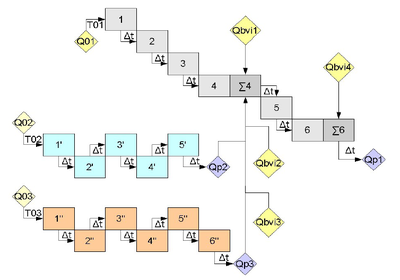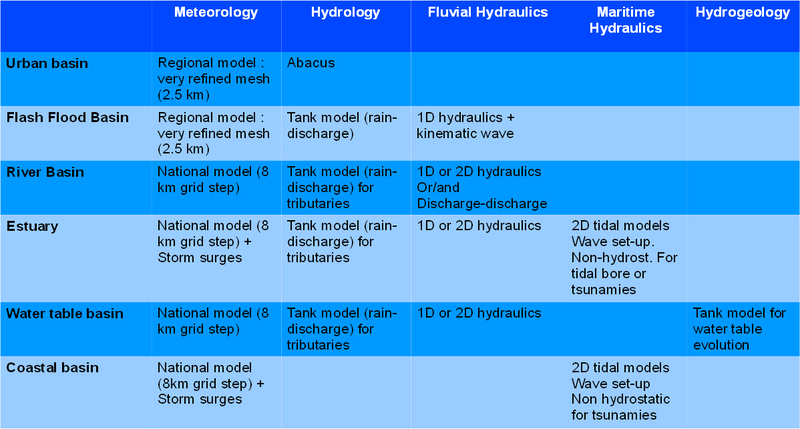Typologie des modèles de prévision des crues/en
 Language: Language: |
Français • English |
Sommaire |
Background information
The European Union Twinning Project for Turkey entitled "Capacity building to implement the Flood Directive” (TR 10 IB EN 01) involves France as "senior partner" and Romania as "junior Partner".
One action conducted for the Turkish Water Directorate is to propose a typology of their watersheds, depending on their hydrological characteristics and on their meteorological regime.
To complete this typology and to continue the mission of advisory of the Turkish Water Directorate, a typology of the simulation models is proposed as follow-up.
This table identifies one or more types of models depending on the main process in each watersheds
Using this table as a LEGO® method
The simulation tools identified in the previous table must be used closely in relation with the characteristics of the sub-basins. Let us take a practical example : given a wide hydrological basin as considered in the Water Framework Directive, we would like to equip it with a set of simulation tools. The method to be used is similar as a LEGO® play-game. We will use it by following the process set-up below:
- identify elementary bricks, that is to partition the wide basin in a series of homogeneous hydrological sub-basins
- locate the available meteorological gauging stations on each sub-basin (rain gauging, radar) and if necessary to plan to equip the basin with a sufficient numbers
- locate the outlet of each sub-basin and verify the presence of a functioning hydrometrical gauging station, able to transmit with an appropriate time step data to a central unit
- this work on the upstream basins will give us the opportunity to determine the hydrological component of our system. One should see if these basins could be equipped with rain-discharge models (given access to meteorological gauging station as well as hydrometrical gauging station)
- during the process of sub-basins aggregation, the rain-discharge relation could begin unappropriated because the main process is no more concentration than propagation. A new model should be used to simulate the flood (water level evolution) or better the inundation (plain overflowing)
- one should identify the existing hydrometrical gauging stations in order to use them as the main measurement network to support numerical modeling
- downstream, the topography and the bathymetry are generally better known, which allows us using 1D hydraulic models to simulate inundation. This could be completed by hydrological rain-discharge models
- further downstream, the plain could begin more hydraulically complicated and using more sophisticated models like 1D cell models or 2D models
- at the sea entrance, the interaction between river discharge and sea conditions : storm surge, wave, necessitates the use or 1D or 2D hydraulic models
- The two following examples shows the way to implement this LEGO® method.
Example n°1 : coupling rain-discharge models with discharge-discharge model
The two figures illustrate the physical domain (left) and the diagram of the flood forecasting systm.
 |

|
Example n°2 : coupling discharge-discharge models
Note : d'autres personnes peuvent avoir contribué au contenu de cet article, [Consultez l'historique]. |
 S'abonner à un flux RSS
S'abonner à un flux RSS
